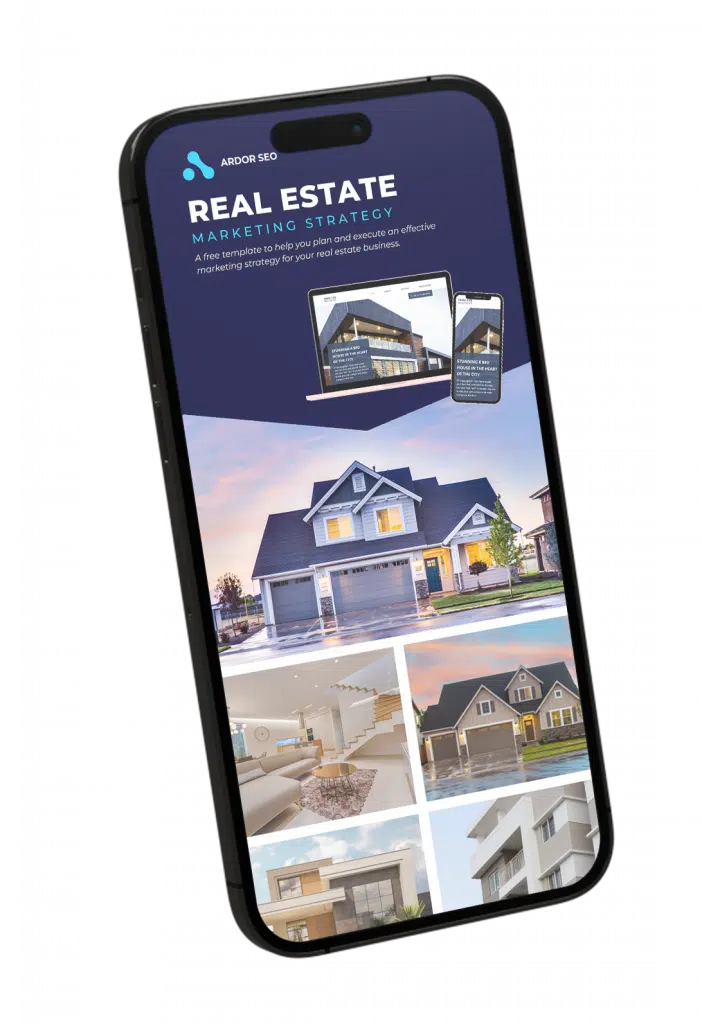
To build real estate websites is to understand where the digital landscape intertwines seamlessly with the world of bricks and mortar. In this era of technological prowess, a captivating online presence is the gateway to success for real estate professionals. Whether you're a seasoned realtor striving to enhance your digital footprint or an aspiring agent ready to make a lasting impression, the art of crafting a real estate website that not only captivates, but also converts, cannot be overlooked.
The Evolution of Real Estate Website Building
Gone are the days when a mere online presence sufficed. Today, creating a real estate website isn't just about showcasing properties; it's about creating an immersive experience that resonates with visitors and transforms them into loyal clients. As potential buyers and sellers navigate the vast expanse of the internet, your website becomes the portal through which they explore properties, neighborhoods, and investment opportunities.
Building a real estate website isn't solely about aesthetics; it's about creating an interactive platform that harmoniously blends functionality with conversion strategies. A website that resonates with your audience's needs, showcases properties vividly, and leads visitors to take action can set you apart in a highly competitive market. But what does it take to craft such a platform?
That's what we'll be exploring today in these ten chapters about how to create a real estate website that converts.
Chapter 1: Setting the Foundation
Before we delve into the intricacies of real estate website building, it's crucial to establish a solid foundation. The purpose of your real estate business website serves as a guiding star, directing its design, content, and functionality. Whether you're targeting buyers, sellers, or both, defining the purpose of your real estate site is paramount.
The journey of creating a real estate website that works well starts with selecting the ideal platform. Renowned content management systems and website builders like WordPress, Wix, and Squarespace offer user-friendly interfaces and customizable templates that streamline the process. Furthermore, embracing responsive design on real estate websites ensures a seamless browsing experience across a variety of devices, catering to the diverse spectrum of users in today's real estate marketplace.
Establishing your real estate website's purpose and carefully choosing the platform form the cornerstone of your success in the competitive real estate market. As we progress through this guide for how to make a website for real estate, keep in mind that a purpose-driven approach and a well-selected platform are instrumental in creating a digital foothold for your real estate business.
Take the First Step
Are you ready to take the first step toward a website that not only impresses but also converts? ArdorSEO is here to partner with you on this transformative journey. Let us guide you through the intricacies of ensuring that your online platform becomes a powerful tool for driving organic traffic and converting leads into loyal clients.
Contact ArdorSEO today and let us help you make your real estate website stand out, captivate, and convert. Your success story awaits!
Chapter 2: Crafting Compelling Content

When discussing the intricacies of crafting a real estate website that resonates, the significance of search engine optimization (SEO) cannot be overstated. Incorporating strategically chosen keywords, such as "homes for sale" and "real estate agents," into your content, URLs, and meta descriptions can significantly enhance your website's visibility on search engine results pages (SERPs), ultimately driving more organic traffic your way.
In the dynamic real estate marketplace, visuals possess unparalleled power to captivate and persuade. High-quality images and videos of properties can serve as the catalyst that captures potential clients' interest, compelling them to delve deeper into your real estate offerings. Implementing features like image sliders, virtual tours, and interactive maps takes the browsing experience to a whole new level, enabling visitors to envision the perfect residential and commercial properties.
Crafting compelling content extends beyond aesthetics; it's about delivering value and answers to the questions your audience seeks. Educational blog posts on market trends, home-buying advice, and local insights position you as a trusted authority in the industry. By offering valuable information, you're fostering a connection with your audience and paving the way for informed decisions.
Chapter 3: Essential Real Estate Website Features
The heart of an effective real estate website lies in its ability to provide visitors with a seamless property search experience. A well-crafted property search feature empowers users to filter listings based on critical criteria such as location, price range, and property type. Implementing real estate widgets for websites can further elevate this experience by showcasing featured listings and recently added properties on your homepage.
When delving into the nuances of crafting a real estate website that converts, comprehensive property listings emerge as a pivotal element. Each listing should go beyond the basics, encompassing high-quality images, detailed property descriptions, notable features, and essential contact information. Augmenting these listings with interactive elements like 360-degree virtual tours, floor plans, virtual and augmented reality, and neighborhood insights enriches the user experience, providing a holistic view of each property.
As visitors explore your real estate website, the navigation should be intuitive and seamless. Well-organized menus, clear categories, and strategically placed calls to action guide users effortlessly through the site. Easy access to essential pages such as property listings, contact information, and informative resources enhances user satisfaction and encourages them to stay longer, improving the chances of conversions.
Chapter 4: Converting Visitors into Clients

Transitioning from a visitor to a valued client hinges on the strategic placement of compelling calls to action throughout your real estate website. These prompts guide users toward taking the desired actions, whether it's scheduling a viewing, requesting more information, or exploring additional listings. Well-crafted CTAs encourage engagement and play a vital role in channeling user intent into meaningful interactions.
Contact forms act as a direct communication channel between you and potential clients. Crafting concise and relevant forms that collect essential information allows for seamless communication. Employing conditional logic in these forms tailors the experience based on the user's objectives – whether they're buying, selling, or simply exploring. An intuitive contact form reduces friction in the lead generation process, optimizing your chances of converting visitors into active clients.
In addition to strategic CTAs and efficient contact forms, transparency is key to fostering trust. Displaying your contact information prominently, offering clear terms of service, and addressing frequently asked questions provides assurance to users. By showcasing your commitment to openness and responsiveness, you instill confidence and enhance the likelihood of conversion from potential clients to property owners.
Chapter 5: Optimization and Analytics
The journey of creating a real estate website that converts doesn't conclude with its launch; it's an ongoing process of refinement. Regularly updating your content, property listings, and blog posts keeps your website fresh and relevant. Consistent updates not only showcase your industry expertise but also signal to search engines that your site is active and valuable to users, positively impacting your SEO rankings.
Delving into the world of optimization requires a data-driven approach. Tools like Google Analytics offer insights into user behavior on your real estate website. Metrics such as page views, bounce rates, and conversion rates shed light on areas that need improvement. Analyzing these metrics empowers you to fine-tune your website, making informed decisions that enhance user experience and drive conversions.
When it comes to optimization, it's essential to adopt a holistic perspective. From content and design to functionality and user experience, each facet plays a role in ensuring your real estate website's success. By consistently optimizing based on data insights, you're not only meeting user expectations but also staying ahead of the competition and maximizing your conversion potential.
Chapter 6: Mobile Responsiveness and Speed

In today's digitally connected world, understanding how to make a real estate website mobile-responsive is no longer a luxury – it's an essential requirement. With a significant portion of users browsing on smartphones and tablets, the process of building a real estate website with responsive design ensures that your platform seamlessly adapts to a multitude of screen sizes. This accessibility goes beyond enhancing user experience; it also has a positive impact on your SEO ranking, as search engines prioritize mobile-friendly websites in their search results.
The speed at which your real estate website loads plays a pivotal role in determining user satisfaction and retention. In an era where instant gratification is the norm, slow-loading pages can be the cause of frustration and high bounce rates. By meticulously optimizing images, harnessing the potential of browser caching, and streamlining your code, you can orchestrate a website that loads swiftly, thereby crafting a seamless and engaging user experience. This environment not only encourages exploration but also sets the stage for successful conversions.
As the mobile era continues to evolve, the importance of ensuring that your real estate website is not only visually appealing but also fully functional across all devices becomes more evident. By dedicating attention to mobile responsiveness and speed, you're effectively laying the groundwork for a website that doesn't just make a first impression, but also successfully converts visitors into valued clients. As we journey through this comprehensive guide on how to build a real estate website, keep in mind that mobile optimization stands as a critical component in the triumphant trajectory of your real estate website.
Chapter 7: Showcasing Your Expertise
Becoming a trusted authority in the real estate industry involves more than just property listings; it's about sharing valuable insights and knowledge. Composing articles that delve into market trends, dispense essential buying and selling tips, and offer comprehensive neighborhood guides encapsulates your commitment to being a valuable source of information. This approach resonates with visitors, paving the path for engagement and conversions.
The significance of real estate widgets for website optimization cannot be overstated. These dynamic tools provide an avenue to not only showcase property listings but also spotlight featured properties and freshly added listings. The integration of real estate widgets on your website is akin to planting signposts that guide visitors on their real estate journey.
Infusing your real estate website with both educational content and authentic client triumphs forges an authoritative and credible brand. By transcending transactional experiences and embracing the educational and personal dimensions of the real estate journey, you engender connections that transcend the virtual realm. As our voyage through the world of crafting conversion-centric real estate websites continues, remember that by showcasing your expertise, you craft an enchanting narrative that reverberates with visitors and ignites the spark of conversions.
Chapter 8: The Power of Social Proof

Today's consumers heavily rely on online reviews and ratings before making purchase decisions. Encourage satisfied clients to leave positive reviews on platforms like Google My Business, Yelp, and Facebook. Integrating these reviews on your website provides tangible evidence of your exceptional services and can significantly influence potential clients' decisions.
In the digital age, showcasing properties on your own website goes beyond static images. Implement interactive virtual tours that allow visitors to explore properties as if they were walking through them. These immersive experiences provide an in-depth understanding of a property's layout and features, making it easier for potential buyers to visualize themselves living there.
Chapter 9: Secure Your Website
Security is paramount in today's online landscape. An SSL certificate encrypts data transmitted between your website and visitors, ensuring their personal information remains confidential. This not only protects your clients but also boosts your website's credibility in the eyes of search engines and visitors alike.
Imagine losing all your property listings, client information, and content due to a technical glitch or cyberattack. Regularly back up your website's data to a secure location to prevent such scenarios. A robust backup strategy ensures that your website can be restored quickly, minimizing downtime and potential data loss.
Chapter 10: Evolving with Trends
As the real estate industry evolves, so should your website. Keep an eye on emerging technologies and real estate widgets for your website like augmented reality (AR) and virtual reality (VR) to create unique and immersive experiences for potential clients. AR apps can help clients visualize furniture placement, while VR tours can transport them into properties without leaving their homes.
Utilize artificial intelligence (AI) to personalize user experiences. Implement chatbots that can answer common questions and guide visitors through your website. AI can analyze user behavior to recommend relevant properties, enhancing engagement and increasing the likelihood of conversions.
Conclusion

From understanding the importance of purpose-driven design to incorporating essential features, optimizing for search engines, and harnessing the power of social proof, your website is poised for success.
Your website is a dynamic entity that should continuously adapt to industry trends and client preferences. Stay ahead of the curve by embracing new technologies and staying committed to optimizing your online platform. Your success story is waiting to be written – start building your exceptional real estate website today.
At ArdorSEO, we specialize in supercharging real estate websites with our expertise in search engine optimization. Let us take your online presence to the next level, driving more organic traffic and converting leads into clients. Contact us today and witness the transformation of your real estate business.

